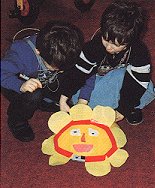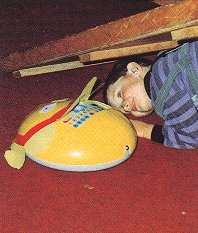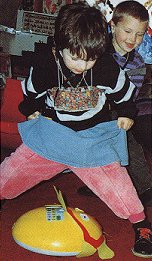
|
Feedback Form

ROAMER WITH HEARING IMPAIRED CHILDREN 1

Bernagh Young teaches deaf children at Cheriton Hearing Impaired Unit, Folkestone. She has found that Roamer stimulates the children to respond and actively engage in communication.
The idea of a toy that would move when a sound was being made seemed the perfect stimulus for getting language going with my group of five 3 to 4 year olds with varying degrees of deafness.
I started my work with Roamer using it in the most basic form. The children loved it, as soon as I took it out of the box the interest was there for them, it was something new and different and unusual. As soon as it moved there were peals of delight, laughter and screams too as everyone thought it was chasing them.

When it stopped the children rushed up to it and began pressing the buttons, quickly discovering that it moved again if they pressed the green "GO" button. Obviously they pressed anything and everything at first and needed guidance on things that would help them - they were totally oblivious to the tonal sounds made by Roamer when the buttons were pressed. I was impressed with the variety of experimentation carried out by the children with relatively little help ... they knocked down towers, went through legs, under tables, tried to run over obstacles and even attempted to climb the slide.
Later we made Roamer into a definite character. A flower was the obvious choice as we'd been watching closely our daffodil bulbs grow. We worked together chattering all the time and I was able to get the children to repeat the individual names of flower parts as we went on. We gave the flower a face to make it more fun as well. The excitement mounted and Helen and John rushed everywhere shouting, "flower" and giggling loudly.
I had to cover the red buttons straight away because the children kept going for them. Also in their impatience to make Roamer move they would press a button several times, causing further delay, however it wasn't long before they got the hang of it. Soon Joe started pushing it round corners in an attempt to get it to move in a more varied way. I changed the program. Now Roamer disappeared under the slide and reappeared on the other side of it much to everyone's approval. Joe disappeared after it too.
John made a tunnel with his legs for Roamer to go under and then sent it off course as it caught on one leg which he thought was very funny. Then we made double and triple tunnels with John the anchor man turning the opposite way round to catch Roamer as it came through his legs.
 |
 |
The ideas and possibilities were endless and I was impressed by the children's constant excited chatter and their cooperation with one another.
Joe and John (a very mischievous combination) were busy making Roamer get stuck under the slide, this meant that someone had to lift it up to let Roamer through ... a sort of drawbridge effect. Everything was fine until Joe decided to extend the experiment by seeing what would happen if he slid down the slide at the same time. In his haste to get up the steps before Roamer got stuck he missed his footing and fell. The poor lad hit his forehead as he landed and although it didn't draw blood, a lump the size of a golf ball came up, so it was necessary, for safety reasons, to put Roamer away. Still, we had had a lot of fun and much laughter, and most importantly, there was much communication ... lots of gesturing, shouting, conversation, facial expression and babble - a real combined effort. Making Roamer into a character definitely made it more appealing. The language potential is certainly phenomenal, even without sensors. With just a short time in play, instances had been created for extending vocabulary and occasions where it could be repeated over and over with ease and fun.
The children were excited by what they were doing and wanted to explore with it and communicate their feelings - excellent!
I decided to extend Roamer's sensor capability by fitting a standard jack plug socket to the front of it thus enabling the programming of a stop and start tapper switch. I was lucky enough to attend a workshop on Roamer control, so thought I knew exactly how it worked. After 3 miserable, unsuccessful hours one weekend I gave up! I had managed to get the lights working, but no joy with the sound sensor. I felt thoroughly fed up and useless, what was I doing wrong?
It turned out that I simply wasn't programming it properly and once I knew the correct sequence it was all systems go. Joe was my first victim. I decided I wanted the children simply to touch "GO" to get Roamer moving, the making a loud sound and it would stop, wait for a couple of seconds, then move again. Joe enjoyed shouting, "Stop!" or rather "0" in his case and successfully managed the task. Mark came in next, he's my deafest boy, but unfortunately the sensors weren't sensitive enough to pick up his weak and warbling little voice. Actually it gave him the impetus to try harder and at one point he actually produced a clear vowel sound, but with no reward he didn't want to try for long.
However the sound sensor does respond to a blown breath and 1 was keen to see whether Mark and Joe could blow hard enough to make Roamer stop. If you hold the sensor close to the mouth it is more sensitive, so for this exercise the children held it in their hands. Joe had no difficulties whatsoever, he blew into the sensor confidently. The concentration of air was short and came from the back of the mouth rather than the front, but it was enough to make the robot stop. He was very pleased with himself and each time we did it he gained more confidence and the control became stronger. I showed Joe, in a mirror, where I wanted the breath to come from and how he needed to close his mouth more and then blow to force the air out. The session wasn't long because I didn't want to overdo things but it worked and will be of definite use again.
Mark found the exercise much harder. Most of his sounds come from the throat and he doesn't inflate his lungs a great deal for this so his breath control is very weak. However he was able to get Roamer to stop when he made a "huh" sound which was just loud enough for it to detect. He was absolutely delighted and keen to try again and again and each time the sound as opposed to the breath became louder and of course his confidence grew. So, finally, he was actually getting it to respond to his sounds. Having the sensor close to his mouth rather than on the back of Roamer made a tremendous difference. He didn't have to crawl around on the floor after it and at last made it accessible to his capabilities.
At a later date I worked again with this stop/start procedure but in a slightly different way. We'd been doing a lot of work on colours so I decided to try to get the children to get Roamer to stop on a coloured spot by saying its name. Helen liked this game very much and had little difficulty in making Roamer stop. She has a loud clear voice but it became evident that certain colour words are easier to pronounce and so more intense and with these Roamer stopped every time whereas with others it wasn't so reliable. Helen's attention span isn't very long and after a few minutes she turned to me and said, "No more flower." I was very pleased with this comment because Helen usually just gets up and walks away or flatly refuses to do any more; she doesn't often tell you outright that she'd had enough, so despite being a negative response it was very promising.
| Back |
|---|